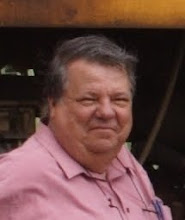Saturday afternoon we started making a triangular section across the corner from the main baseboard section to the 300 mm wide return made the previous Sunday. To do this we needed to cut two short L-girders at 45 degrees on the ends. I turned these pieces this way and that but wasn’t certain. I also didn’t trust my power sawing abilities. Rang Craig and he offered to cut these pieces using his new bench saw. Well, I say new, but he had purchased it some 12 months ago but it was still a virgin as far as use goes. Raymond and I went over to Craig’s where he twisted and turned the two lengths of L-Girder. Made one cut – looked OK. Started the second cut – in the wrong place! Made a few adjustments and tried again – success this time. The next two cuts were achieved with no dramas.
It is now the 1st of April and work continues to be hampered by the battery drill which can’t keep a charge so we changed over to a Makita electric drill which hadn’t been used for more than 10 years. Fortunately, it did not short circuit the house power like the B&D power saw had done a few weeks ago.
The next day Raymond had the day off work so he borrowed his mother’s car and went down to Bunnings, Browns Plains to see if my stories about the Bunnings Team Members are true. Actually, he went down to buy a new battery drill as it was obvious the battery in my old Ryobi was dead. One of the helpful young ladies at Bunnings managed to sell him a Bosch electronic battery drill for $224. I think it has all the bells and whistles on it and even came with a spare battery! Obviously the Bunnings staff impressed him. Work on other sections of the baseboard framework continued through the first few weeks in April. We were now ready to lay some track.
After some debate as where we should start and how best we should go about it we finally started laying the first sections of track. The first length of flex track I had to cut I tried using an old pair of rail cutters (Shark) but all I succeeded in doing was to twist the rails off the sleepers. After a few harsh words and losing a track pin or two on the garage floor, Raymond said – “I told you to use the Dremel”.

The first sections of track are laid. April 2007


I changed over to the Dremel with a cut-off wheel – no problems to cut the track now! I now succeeded in laying two points and a couple of lengths of flex track.
Track laying continued with the installation of one of the passing loops which contained the most points in a short distance (five) and continued on to lay track around to the return baseboard against the garage wall. We had considerable problems with laying out the curves as the improvised trammel and camera tripod we were using kept giving us conflicting results.
During the joining up of the other three passing loops had to redo a section as two of the points were incorrectly located. Finally we achieved what we thought was a good result.
While I was at work the next day, Raymond tested the track sections laid using his Broadway Limited C-16 2-8-0 which he pushed around the curves and behold he found a problem! The first sections of track we had laid appeared fine but the curves at the other end of the station yard that had given us so much grief when we were laying them out on Wednesday showed a problem. The C-16 would only go around them when the tender was not close coupled. We tried measuring the curves and started to get the idea that the curves were much sharper than the 34” and 30” we thought we had laid.
We tried the Tracksettas when we got home and found our troublesome curves to be about 24” radius or even a bit less. They will have to be relaid! Our other curves were all 30” or above and were considered fine (although not as large a radius as we had thought, we had – 34 to 36”)

No comments:
Post a Comment